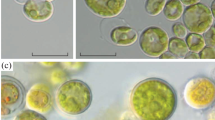Abstract
The specific Bchl a and c content of the vitamin B12-dependent Chlorobium limicola strain 1230 decreased strongly under vitamin B12 limitation. In comparison to a regularly grown culture (20 μg vitamin B12/l) the specific Bchl c content of a B12-limited culture was reduced to 20% and the specific Bchl a content to 42%. By ultrathin sections it could be clearly demonstrated that B12-deficient cells contained no chlorosomes. After the addition of vitamin B12 to a deficient culture, chlorosomes were formed and the Bchl a and c content increased again to the level of regularly grown cells. The brown-colored Chlorobium phaeobacteroides strain 2430 (type strain) and the extremely low-light-adapted strain MN1 were compared with respect to the influence of light on the formation of chlorosomes and the Bchl e and carotenoid content. By ultrathin sections it could be demonstrated that strain MN1 produced two-fold larger chlorosomes. Chlorosome dimensions of strain MN1 decreased with increasing light intensities. The number of chlorosomes per cell in both strains did not change with different light intensities. Strain MN1 formed twice as much Bchl e as the type strain when grown at 30 or below 1 μmol · m-2 · s-1. Under comparable light conditions strain MN1 formed 14–57% more carotenoids than the type strain. Low light intensities aaused the carotenoid content to increase by 25% in strain 2430 in comparison to high light intensity.
Similar content being viewed by others

References
Bradford MM (1976) A rapid and sensitive method for the quantitation of microgram quantities of protein utilizing the principle of protein-dye binding. Anal Biochem 72: 248–254
Broch-Due M, Ormerod JG, Fjerdingen BS (1978) Effect of light intensity on vesicle formation in Chlorobium. Arch Microbiol 116: 269–274
Fuchs G, Stupperich E, Eden G (1980) Autotrophic CO2 fixation in Chlorobium limicola. Evidence for the operation of a reductive tricarbolic acid cycle in growing cells. Arch Microbiol 128: 64–71
Halpern J (1985) Mechanisms of coenzyme B12-dependent rearrangements. Science 227: 869–875
Holo H (1989) Chloroflexus aurantiacus secretes 3-hydroxypropionate, a possible intermediate in the assimilation of CO2 and acetate. Arch Microbiol 151: 252–256
Holo H, Broch-Due M, Ormerod JG (1985) Glycolipids and the structure of chlorosomes in green bacteria. Arch Microbiol 143: 94–99
Holt SC, Conti SF, Fuller RC (1966) Effects of light intensity on the formation of the photochemical apparatus in the green bacterium Chloropseudomonas ethylicum. J Bacteriol 91: 349 to 355
Lorenz RJ (1984) Grundbegriffe der Biometrie. Fischer, Stuttgart New York
Ormerod JG, Nesbakken T, Beale SI (1990) Specific inhibition of antenna bacteriochlorophyll synthesis in Chlorobium vibrioforme by anesthetic gases. J Bacteriol 172: 1352–1360
Overmann J (1991) Standortspezifische Anpassung bei phototrophen Schwefelbakterien. Doctoral thesis, Universität Konstanz, Germany
Overmann J, Cypionka H, Pfennig N (1992a) An extremely low light adapted phototrophic sulfur bacterium from the Black Sea. Limnol Oceanogr 37: 150–155
Overmann J, Fischer U, Pfennig N (1992b) A new purple sulfur bacterium from saline littoral sediments, Thiorhodovibrio winogradskyi gen. nov. and sp. nov. Arch Microbiol 157: 329–335
Pfennig N, Lippert KD (1966) Über das Vitamin B12-Bedürfnis phototropher Schwefelbakterien. Arch Mikrobiol 55: 245–256
Pfennig N, Trüper HG (1989) Anoxygenic phototrophic bacteria. In: Staley JT, Bryant MP, Pfennig N, Holt JG (eds) Bergey's manual of systematic bacteriology, vol 3. Williams and Wilkins, Baltimore, pp 1635–1709
Pierson BK, Castenholz RW (1974) Studies of pigments and growth in Chloroflexus aurantiacus, a phototrophic filamentous bacterium. Arch Microbiol 100: 283–305
Schmidt K, Maarzahl M, Mayer F (1980) Development and pigmentation of chlorosomes in Chloroflexus aurantiacus strain Ok-70-fl. Arch Microbiol 127: 87–97
Siefert E, Pfennig N (1984) Convenient method to prepare neutral sulfide solution for cultivation of phototrophic sulfur bacteria. Arch Microbiol 139: 100–101
Spurr AR (1969) A low-viscosity epoxy resin embedding medium for electron microscopy. J Ultrastruct Res 26: 31–43
Stal LJ, Van Gemerden H, Krumbein WE (1984) The simultaneous assay of chlorophyll and bacteriochlorophyll in natural microbial communities. J Microbiol Methods 2: 295–306
Steinmetz MA, Fischer U (1981) Cytochromes of the non-thiosulfate-utilizing green sulfur bacterium Chlorobium limicola. Arch Microbiol 130: 31–37
Steinmetz MA, Fischer U (1982) Cytochromes of the green sulfur bacterium Chlorobium vibrioforme f. thiosulfatophilum. Purification, characterization and sulfur metabolism. Arch Microbiol 131: 19–26
Stupperich E, Schurr S (1991) Detection of a corrinoid in the chlorosome membranes from the phototroph Chloroflexus aurantiacus. BIOforum 1/2, V13: 11
Stupperich E, Eisinger HJ, Schurr S (1990) Corrinoids in anaerobic bacteria. FEMS Microbiol Rev 87: 355–360
Taylor RT (1982) B12-dependent methionine biosynthesis. In: Dolphin D (ed) B 12, vol 2. Wiley, New York, pp 307–355
Trüper HG, Pfennig N (1991) The family Chlorobiaceae. In: Balows A, Trüper HG, Dworkin M, Harder W, Schleifer KH (eds) The prokaryotes, 2nd edn., vol IV. Springer, New York Berlin Heidelberg, pp 3583–3592
Wagner-Huber R, Fischer U, Brunisholz R, Rümbeli M, Frank G, Zuber H (1990) The primary structure of the presumable BChl d-binding polypeptide of Chlorobium vibrioforme f. thiosulfatophilum. Z Naturforsch 45c: 818–822
Zuber H, Brunisholz RA (1991) Structure and function of antenna polypeptides and chlorophyll-protein complexes: principles and variability. In: Scheer H (ed) Chlorophylls. CRC Press, Boca Raton, Florida, pp 627–703
Author information
Authors and Affiliations
Rights and permissions
About this article
Cite this article
Fuhrmann, S., Overmann, J., Pfennig, N. et al. Influence of vitamin B12 and light on the formation of chlorosomes in green- and brown-colored Chlorobium species. Arch. Microbiol. 160, 193–198 (1993). https://doi.org/10.1007/BF00249124
Received:
Accepted:
Issue Date:
DOI: https://doi.org/10.1007/BF00249124


